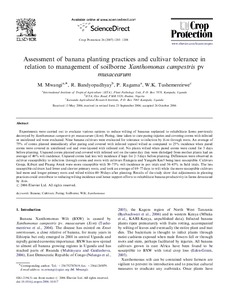| dc.contributor.author | Mwangi, M. |
| dc.contributor.author | Bandyopadhyay, Ranajit |
| dc.contributor.author | Ragama, P. |
| dc.contributor.author | Tushemereirwe, W.K. |
| dc.date.accessioned | 2019-12-04T11:19:33Z |
| dc.date.available | 2019-12-04T11:19:33Z |
| dc.date.issued | 2007 |
| dc.identifier.citation | Mwangi, M., Bandyopadhyay, R., Ragama, P. & Tushemereirwe, W.K. (2007). Assessment of banana planting practices and cultivar tolerance in relation to management of soilborne Xanthomonas campestris pv musacearum. Crop protection, 26(8), 1203-1208. |
| dc.identifier.uri | https://hdl.handle.net/20.500.12478/3486 |
| dc.description.abstract | Experiments were carried out to evaluate various options to reduce wilting of bananas replanted to rehabilitate farms previously destroyed by Xanthomonas campestris pv musacearum (Xcm). Paring, time taken to cure paring injuries and covering corms with infested or uninfested soil were evaluated. Nine banana cultivars were evaluated for tolerance to infection by Xcm through roots. An average of 75% of corms planted immediately after paring and covered with infested topsoil wilted as compared to 25% incidence when pared corms were covered in uninfested soil and over-layered with infested soil. No plants wilted when pared corms were cured for 3 days before planting. Unpared corms planted and covered with infested soil on the same day they were dislodged from mother plants had an average of 40% wilt incidence. Unpared corms had less wilt incidence if kept for 2–3 days before planting. Differences were observed in cultivar susceptibility to infection through corms and roots with cultivars Enzagata and Yangabi Km5 being least susceptible. Cultivars Gonja, Kibuzi and Pisang Awak were more susceptible with 50–75% wilt incidence in pot trials and 36–45% in field trials. The less susceptible cultivars had fewer and shorter primary roots, and took an average of 69–77 days to wilt while the more susceptible cultivars had more and longer primary roots and wilted within 40–50 days after planting. Results of the study show that adjustments in planting practices could contribute to reducing wilting incidence and hence support efforts to rehabilitate banana productivity in farms devastated by Xcm. |
| dc.language.iso | en |
| dc.subject | Cultivars |
| dc.subject | Paring |
| dc.subject | Soilborne |
| dc.subject | Wilt |
| dc.subject | Xanthomonas |
| dc.subject | Corms |
| dc.subject | Bananas |
| dc.subject | Bacteria |
| dc.subject | Inoculums |
| dc.subject | Pathogen |
| dc.title | Assessment of banana planting practices and cultivar tolerance in relation to management of soilborne Xanthomonas campestris pv musacearum |
| dc.type | Journal Article |
| dc.description.version | Peer Review |
| cg.contributor.affiliation | International Institute of Tropical Agriculture |
| cg.contributor.affiliation | Kawanda Agricultural Research Institute, Uganda |
| cg.coverage.region | Africa |
| cg.coverage.region | East Africa |
| cg.coverage.country | Uganda |
| cg.isijournal | ISI Journal |
| cg.authorship.types | CGIAR and developing country institute |
| cg.iitasubject | Disease Control |
| cg.iitasubject | Banana |
| cg.iitasubject | Plant Production |
| cg.iitasubject | Pests Of Plants |
| cg.iitasubject | Plant Breeding |
| cg.iitasubject | Plant Diseases |
| cg.iitasubject | Plant Genetic Resources |
| cg.iitasubject | Food Security |
| cg.iitasubject | Handling, Transport, Storage And Protection Of Agricultural Products |
| cg.iitasubject | Agribusiness |
| cg.accessibilitystatus | Limited Access |
| local.dspaceid | 95457 |
| cg.identifier.doi | https://doi.org/10.1016/j.cropro.2006.10.017 |

